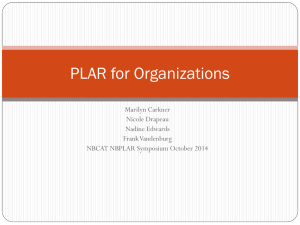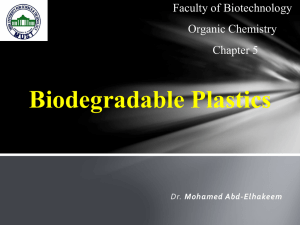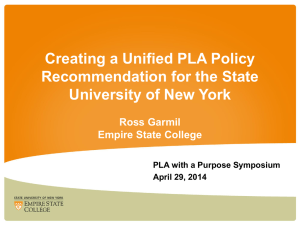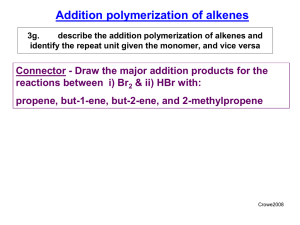9.Biopolymers
advertisement
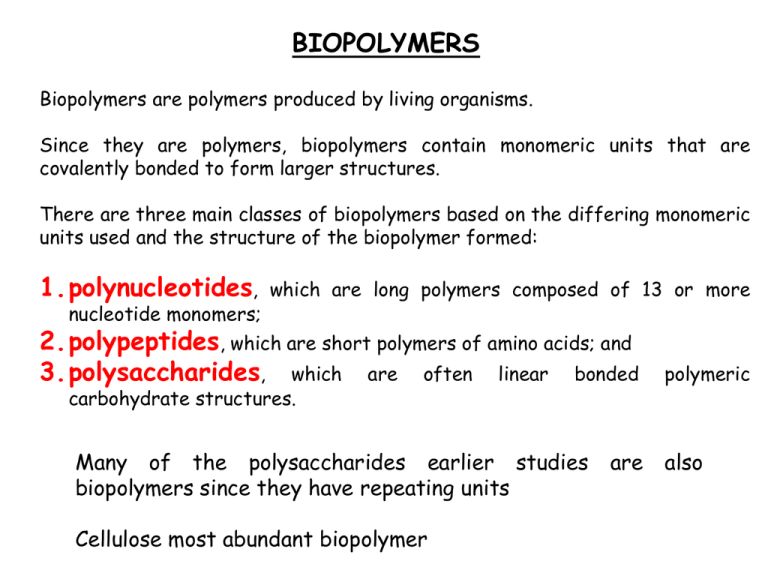
BIOPOLYMERS Biopolymers are polymers produced by living organisms. Since they are polymers, biopolymers contain monomeric units that are covalently bonded to form larger structures. There are three main classes of biopolymers based on the differing monomeric units used and the structure of the biopolymer formed: 1.polynucleotides, nucleotide monomers; which are long polymers composed of 13 or more 2.polypeptides, which are short polymers of amino acids; and 3.polysaccharides, which are often linear bonded carbohydrate structures. Many of the polysaccharides earlier studies biopolymers since they have repeating units Cellulose most abundant biopolymer are polymeric also Synthetic polymers are much simpler and random and molecular mass. This fact leads to a molecular mass distribution that is missing in biopolymers. All biopolymers of a type (say one specific protein) are all alike: they all contain the similar sequences and numbers of monomers and thus all have the same mass. This phenomenon is called monodispersity in contrast to the polydispersity encountered in synthetic polymers. As a result biopolymers have a polydispersity index of 1. BIOPOLYMERS AS MATERIALS • Some biopolymers- such as polylactic acid (PLA), naturally occurring zein, and poly-3-hydroxybutyrate can be used as plastics, replacing the need for polystyrene or polyethylene based plastics. • Some plastics are now referred to as being 'degradable', 'oxydegradable' or 'UV-degradable'. This means that they break down when exposed to light or air, but these plastics are still primarily (as much as 98 per cent) oil-based and are not currently certified as 'biodegradable' under certain international laws. • Biopolymers, however, will break down and some are suitable for domestic composting. Zein is a class of prolamine protein found in maize. It is usually manufactured as a powder from corn gluten meal. BIOPOLYMER USES • Biopolymers (also called renewable polymers) are produced from biomass for use in the packaging industry. • Biomass comes from crops such as sugar beet, potatoes or wheat: when used to produce biopolymers, these are classified as non food crops. These can be converted in the following pathways: • Sugar beet > Glyconic acid > Polyglonic acid • Starch > (fermentation) > Lactic acid > Polylactic acid (PLA) • Biomass > (fermentation) > Bioethanol > Ethene > Polyethylene • Many types of packaging can be made from biopolymers: food trays, blown starch pellets for shipping fragile goods, thin films for wrapping. Polylactic acid (PLA) Poly(lactic acid) or polylactide (PLA) is a polyester thermoplastic aliphatic commonly made from a-hydroxy acids, derived from renewable resources, such as • corn starch (in the United States), • tapioca products (roots, chips or starch mostly in Asia) or • sugarcanes (in the rest of world). It can biodegrade under certain conditions, such as the presence of oxygen, and is difficult to recycle. PLA is not a polyacid (polyelectrolyte), but rather a polyester Polylactic acid (PLA) • One of the few polymers in which the stereochemical structure can easily be modified by polymerizing a controlled mixture of L and D isomers to yield high molecular weight and amorphous or semicrystalline polymers. • Properties can be both modified through the variation of isomers (L/D ratio) and the homo and (D, L) copolymers relative contents. • PLA can be tailored by formulation involving adding plasticizers, other biopolymers, fillers, etc Polylactic acid (PLA) Bacterial fermentation is used to produce lactic acid from corn starch or cane sugar. Two lactic acid molecules undergo a single esterfication and then catalytically cyclized to make a cyclic lactide ester. PLA of high molecular weight is produced from the dilactate ester by ringopening polymerization. Polymerization of a racemic mixture of L- and D-lactides usually leads to the synthesis of poly-DL-lactide (PDLLA) which is amorphous. Stannous octonate Or tin(II) chloride Catalytic and thermolytic ring-opening polymerization of lactide (left) to polylactide (right) poly-DL-lactide (PDLLA) PDLA (poly-D-lactide): Due to the chiral nature of lactic acid, several distinct forms of polylactide exist: poly-Llactide (PLLA) is the product resulting from polymerization of L,L-lactide (also known as Llactide). heat resistant PLA can withstand temperatures of 110C (230F) optically transparent. PLA has similar mechanical properties to PETE polymer, but has a significantly lower maximum continuous use temperature. PETE: Polyethylene terephthalate, commonly abbreviated PET, PETE, or the obsolete PETP or PET-P, is a thermoplastic polymer resin of the polyester family and is used in synthetic fibers; beverage, food and other liquid containers Polylactic acid (PLA): Biodegradability • PLA is considered both as biodegradable (e.g. adapted for short-term packaging) and as biocompatible in contact with living tissues (e.g. for biomedical applications such as implants, sutures, drug encapsulation, etc.). • PLA can be degraded by abiotic degradation (i.e. simple hydrolysis of the ester bond without requiring the presence of enzymes to catalyze it). During the biodegradation process, and only in a second step, the enzymes degrade the residual oligomers till final mineralization (biotic degradation). • As long as the basic monomers (lactic acid) are produced from renewable resources (carbohydrates) by fermentation, PLA complies with the rising worldwide concept of sustainable development and is classified as an environmentally friendly material. APPLICATIONS • Woven shirts (ironability), microwavable trays, hot-fill applications and even engineering plastics (in this case, the stereocomplex is blended with a rubber-like polymer such as ABS). • PLA is currently used in a number of biomedical applications, such as sutures, stents, dialysis media and drug delivery devices. The total degradation time of PLA is a few years. It is also being evaluated as a material for tissue engineering. • Because it is biodegradable, it can also be employed in the preparation of bioplastic, useful for producing loose-fill packaging, compost bags, food packaging, and disposable tableware. In the form of fibers and non-woven textiles, PLA also has many potential uses, for example as upholstery, disposable garments, awnings, feminine hygiene products, and diapers. • PLA is a sustainable alternative to petrochemical-derived products, since the lactides from which it is ultimately produced can be derived from the fermentation of agricultural by-products such as corn starch or other carbohydrate-rich substances like maize, sugar or wheat. • PLA can be an alternative to high-impact polystyrene by using as much as 1 wt% non-PLA due to creating co-polymers which can strengthen PLA plastic. PLA is more expensive than many petroleum-derived commodity plastics, but its price has been falling as production increases. The demand for corn is growing, both due to the use of corn for bioethanol and for corn-dependent commodities, including PLA. Plastics are resistant to biodegradation accumulating at the rate of 25million tonnes per year. Much disposed in landfill sites. Possibility of recycling plastics is limited and incineration yields toxic compounds As of Jun 2010, NatureWorks was the primary producer of PLA (bioplastic) in the United States. The Korean research center KAIST has announced that they have found a way to produce PLA using bio-engineered Escherichia coli. Due to PLA's relatively low glass transition temperature, PLA cups cannot hold hot liquids. However, much research is devoted to developing a heat resistant PLA Biodegradable cups at a restaurant Mulch film made of polylactic acid (PLA)-blend bio-flex Degradable plastics can be biodegradable or photodegradable Photodegradable plastics can break down to small fragments and lose structure but small fragments are not degradable. Biodegradable plastics can be metabolized by MO Semidegradable plastics contain starch, cellulose and polyethene For complete degradation 50% mix is required which compromises structural properties Biodegradable plastics Polyhydroxy alkanoates (PHAs): PHB Polyactides Aliphatic polyesters Polysaccharides Blends of above Bioplastics from Microorganisms Degradable polymers that are naturally degraded by the action of microorganisms such as bacteria, fungi and algae Benefits • 100 % biodegradable • Produced from natural, renewable resources • Able to be recycled, composted or burned without producing toxic byproducts Several legislations enacted but demand for bioplastics have not increased IMPORTANCE • 2003- North America – 107 billion pounds of synthetic plastics produced from petroleum – Take >50 years to degrade – Improper disposal and failure to recycle overflowing landfills Carbon Cycle of Bioplastics Photosynthesis Plants CO2 H2O Biodegradation Recycle Carbohydrates Fermentation Plastic Products PHA Polymer Polyhydroxyalkanoates (PHAs) • Polyesters accumulated inside microbial cells as carbon & energy source storage Ojumu et al., 2004 Polyhydroxyalkanoates (PHAs) • Produced under conditions of: – Low limiting nutrients (P, S, N, O) – Excess carbon 2 different types: Short-chain-length Medium-chain-length 3-5 Carbons 6-14 Carbons ~250 different bacteria have been found to produce some form of PHAs Polyhydroxybutyrate (PHB) • Example of short-chain-length PHA • Produced in activated sludge • Found in Alcaligenes eutrophus • Accumulated intracellularly as granules (>80% cell dry weight) Lee et al., 1996 PHA Biosynthesis Ojumu et al., 2004 PHB: polyhydroxybutyrate Intracellular microbial plastic first found in Bacillus megaterium 80 different types of PHAs formed from 3-hydroxyalkanoate acid monomers 3-14 carbons in length Energy store when nutrient is limited Alcaligenes eutrophus (Ralstnia etropha) to produce PHB Polymer had low thermal stability and brittle Addition of propionate to culture produced P (3HB-co-3HV) and polymer was flexible and tough Marketed as BIOPOLTM used to make films, coated paper, compost bags, disposable foodwares , bottles, razors COST is still HIGHER than chemically synthesized polymers Propylene: 1$/kg PHVB: 3-5$/kg HB: hydroxybutyrate HV: hydroxyvalerate phbC-A-B Operon in A. eutrophus • Structural genes encoded in single operon – PHA synthase – b-ketothiolase – NADPH-dependent acetoacetyl-CoA reductase Lee et al., 1996 Recovery of PHAs from Cells • PHA producing microorganisms stained with Sudan black or Nile blue • Cells separated out by centrifugation or filtration • PHA is recovered using solvents (chloroform) to break cell wall & extract polymer • Purification of polymer Bioplastic Properties • Some are stiff and brittle – Crystalline structure rigidity • Some are rubbery and moldable • Properties may be manipulated by blending polymers or genetic modifications • Degrades at 185°C • Moisture resistant, water insoluble, optically pure, impermeable to oxygen • Must maintain stability during manufacture and use but degrade rapidly when disposed of or recycled Biodegradation • Fastest in anaerobic sewage and slowest in seawater • Depends on temperature, light, moisture, exposed surface area, pH and microbial activity • Degrading microbes colonize polymer surface & secrete PHA depolymerases • PHA CO2 + H2O (aerobically) • PHA CO2 + H2O + CH4 (anaerobically) Biodegradation by PHA depolymerases Conclusions • Need for bioplastic optimization: – Economically feasible to produce – Cost appealing to consumers – Give our landfills a break How many of you would be willing to pay 2-3 times more for plastic products because they were “environmentally friendly”?
